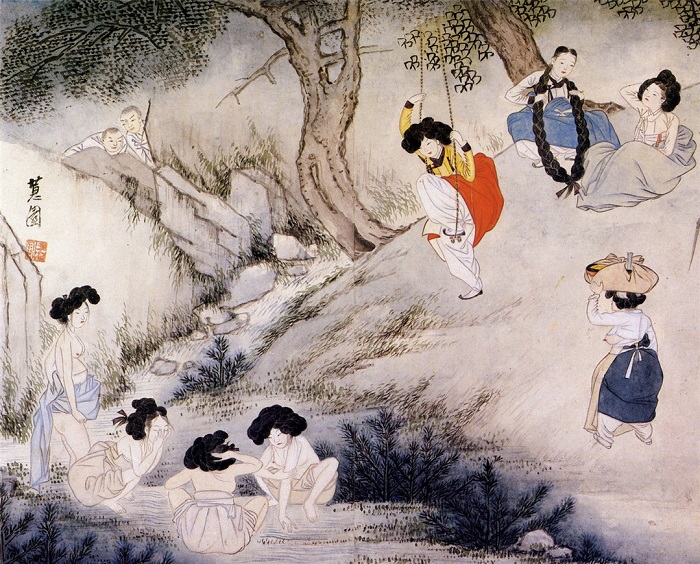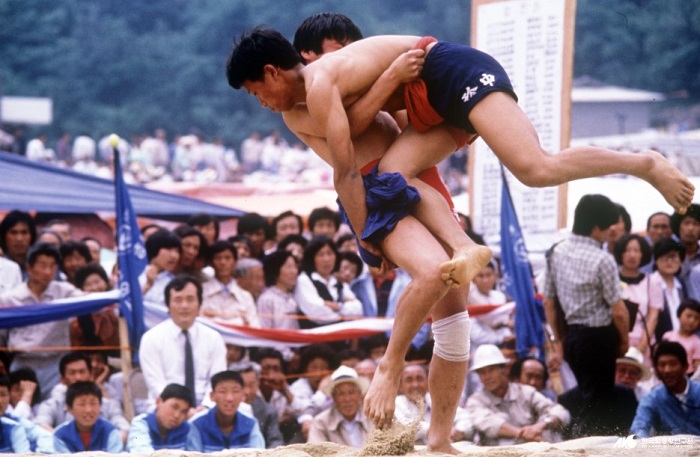The holiday of Dano (단오, 端午) falls on Thursday, June 9, this year, and corresponds to the fifth day of the fifth lunar month. Dano is the smallest of modern South Korea's three most-celebrated traditional holidays, the other two being the Chuseok Mid-Autumn Festival (추석, 秋夕) in September/ October and Seollal Lunar New Year's (설날) in January/ February.
Dano is literally "the first fifth". Dan (단, 端) means "first" and o (오, 午) means "five". Traditionally, the day was believed to be filled with positive yang energy, and in ancient times when people worshipped the sun and the moon, Dano was a day for the sun god.
Dano has always been a day of decorations, a day to enjoy the summer. People would wash and put on new sets of clothes and there was a whole range of "Dano decorations" (단오장, 端午粧).

At Joseon palaces, members of the royal court would present the ruling monarch with a book of Dano poetry (단오첩, 端午帖). The king, in turn, would present them with special Dano fans made by artisans and which were tributes from the provinces. Households would hold special ancestral rites (단오절사, 端午節祀) in which they'd offer up newly picked cherries on the offering table. Families would hold another ceremony (단오고사, 端午告祀) to pray for peace in the family, a rich harvest and prosperity. Women would traditionally wash their hair this day with an aromatic type of iris (창포, 菖蒲) (Acorus calamus var. angustatus). They would also put Angelica polymorpha (궁궁이) flowers in their hair in the belief that the unique aroma would repel evil.

Modern South Korea has retained many traditional festivals surrounding Dano, including the Gangneung Danoje Festival (강릉단오제). It is listed as one of the official UNESCO Masterpieces of the Oral and Intangible Heritage of Humanity. As it says at the UNESCO homepage, "The festival includes a shamanistic ritual on the Daegwallyeong Ridge, which pays tribute to the mountain deity and male and female tutelary deities. It encompasses traditional music and Odokddegi folk songs, the Gwanno mask drama, oral narrative poetry, and various popular pastimes." Nowadays, the festival includes one of the largest open-air markets in the country.
Korea.net
Photos: National Folk Museum of Korea
Dano is literally "the first fifth". Dan (단, 端) means "first" and o (오, 午) means "five". Traditionally, the day was believed to be filled with positive yang energy, and in ancient times when people worshipped the sun and the moon, Dano was a day for the sun god.
Dano has always been a day of decorations, a day to enjoy the summer. People would wash and put on new sets of clothes and there was a whole range of "Dano decorations" (단오장, 端午粧).

'Sceneray on Dano Day' (단오풍정 端午風情), painted by Shin Yun-bok (1758-?) (신윤복, 申潤福), is one of Korea's most famous representations of the holiday Dano. On Dano, women would traditionally wash their hair with aromatic flowers.
At Joseon palaces, members of the royal court would present the ruling monarch with a book of Dano poetry (단오첩, 端午帖). The king, in turn, would present them with special Dano fans made by artisans and which were tributes from the provinces. Households would hold special ancestral rites (단오절사, 端午節祀) in which they'd offer up newly picked cherries on the offering table. Families would hold another ceremony (단오고사, 端午告祀) to pray for peace in the family, a rich harvest and prosperity. Women would traditionally wash their hair this day with an aromatic type of iris (창포, 菖蒲) (Acorus calamus var. angustatus). They would also put Angelica polymorpha (궁궁이) flowers in their hair in the belief that the unique aroma would repel evil.

The festival of Dano keeps alive many ancient traditions, from sacred rites and spirit dances, through to foods and sports. Ssireum, or traditional Korean wrestling, is often played on Dano at the Gangneung Danoje Festival. The festival is one of the largest Dano festivals in the country, and is even registered with UNESCO.
Modern South Korea has retained many traditional festivals surrounding Dano, including the Gangneung Danoje Festival (강릉단오제). It is listed as one of the official UNESCO Masterpieces of the Oral and Intangible Heritage of Humanity. As it says at the UNESCO homepage, "The festival includes a shamanistic ritual on the Daegwallyeong Ridge, which pays tribute to the mountain deity and male and female tutelary deities. It encompasses traditional music and Odokddegi folk songs, the Gwanno mask drama, oral narrative poetry, and various popular pastimes." Nowadays, the festival includes one of the largest open-air markets in the country.
Korea.net
Photos: National Folk Museum of Korea
Most popular
- Slew of festivals, events scheduled in downtown Seoul in May
- Korea.net welcomes 2025 K-influencers, Honorary Reporters
- 2025 Honorary Reporter class pledges to spread 'real Korea' worldwide
- US urged to exempt tariffs on Korea in first '2+2' trade talks
- Korean culture festival in Cuba marks 1st year of bilateral ties
